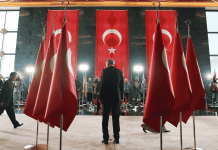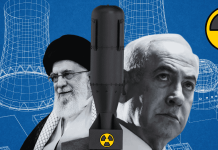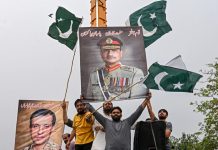It was compared to the biblical story where a small force of soldiers emerged from beneath the earth and surprised and overwhelmed a much larger force to save the motherland.
In Russia, the soldiers who took part in the so-called pipeline offensive in the Kursk region (Operation Stream – Potok in Russian) in March this year, became the stuff of legends and were welcomed back home as “heroes.” Russian bloggers commented that the Operation would “go down in history books,” and many of the soldiers were awarded for their bravery.
“Blow up all your pipes out of fear… We’ll still come to you from under the ground,” boasted a new Russian war song on the daring mission, first performed outside a church in central Russia, with a 50-foot replica of the pipeline in the background for the people to admire.
However, in Ukraine, the story flipped 180 degrees. The operation was termed a ‘total failure,’ which resulted in the “massacre” of hundreds of Russian soldiers. The Russian soldiers who took part in the ill-planned operation were not heroes, but victims of poor and careless military planning, Kyiv claimed.
There is little clarity on what precisely the operation achieved and whether it should be termed a success or failure. All analysts, irrespective of their nationality, agree that the mission was daring and unconventional, but did it achieve its goals?

Now, more than five months after the operation, the Armed Forces of Ukraine (AFU) finally seem to be acknowledging, though grudgingly, that they were taken by surprise and the operation might have helped Russia in taking back substantial territory in the Kursk region.
Ukraine Acknowledges ‘They Were Unprepared’
Ukrainian Commander-in-Chief Alexander Syrsky has admitted that the Ukrainian army did not expect Russian troops to take bold actions such as their Operation Pipeline in the Kursk Region.
“We had intelligence that they might use gas pipelines. Our forces were ordered to take those under control and monitor the areas where enemy soldiers could come to the surface. Still, we must have missed something out, or, perhaps, we did not expect them to be that bold,” Syrsky said in an interview with Ukraine’s TSN TV channel.
Further, Syrsky admitted that the Russian army’s operation had made it more complicated for Ukrainian forces to retreat from the Kursk Region.
However, despite these setbacks, Syrsky termed the Kursk operation a spectacular success.
First Anniversary Of Ukraine’s Kursk Operation
Notably, August 6 marked the first anniversary of Ukraine’s Kursk operation in which Kyiv was able to occupy hundreds of miles of Russian territory.
According to Syrsky, Ukrainian troops were able to break through Russian defense, enter deep into the Russian military’s rear, and disrupt the logistical support of the Russian forces operating in Ukrainian territory.
“During the most active period of the operation, the Ukrainian Armed Forces controlled up to 1,300 square kilometers of the territory of the Kursk region of the Russian Federation,” Syrsky claimed.
“The operation forced Russia to shift significant reserves to the north, which weakened its pressure on other sections of the front. We did not allow the enemy to carry out an offensive and created a buffer zone. It is thanks to this that Sumy and Kharkiv remain free,” Syrsky emphasized.
He also claimed that Russia lost more than 77,000 soldiers (killed and wounded) in Kursk, of which nearly 4,000 were citizens of North Korea.
“Ukrainian defenders also captured 1,018 Russian soldiers, which allowed for exchanges and the return home of hundreds of Ukrainian soldiers, including those who had been in captivity since 2022,” Syrsky said.
According to the commander-in-chief, Ukrainian forces still maintain a presence in the Glushkovsky district of the Kursk region, holding back part of the Russian offensive group.
Russian Counteroffensive In Kursk
Ukraine’s Kursk operation was a major setback for Russia, both militarily and in terms of Russian prestige.
It was the first time since the Second World War that Russia had lost part of its territory. The operation was also a big morale booster for the Ukrainian armed forces as it was the first time since the start of the war that Kyiv had taken the battle to Russian territory.
After being taken by surprise and losing hundreds of square miles of territory within weeks, Russia began its slow and grinding counteroffensive, which involved throwing thousands of soldiers into frontal meat grinder assaults.
By October-end, Ukrainian intelligence reported the presence of about 12,000 North Korean soldiers, including 500 officers and three generals, in the Kursk theatre of operation.
Despite the slow progress of Russian forces and heavy casualties, by January 2025, it became apparent that the Ukrainian troops faced imminent defeat in Kursk.
Eurasian Times reported in January this year that Kyiv faces the stark choice of choosing between swift retreat or crushing defeat in Kursk.
By March, Russia had retaken from Ukrainian forces nearly 70% of the territory they had lost in Kursk.
Op Stream: Russia’s Daring ‘Pipeline Offensive’
The Operation Stream (Potok) began on March 8.
Interestingly, the US had cut intelligence-sharing with Ukraine from March 5 to March 11, following a disastrous outing by President Volodymyr Zelenskyy to the White House on February 28, where he had a public spat with US President Donald Trump and Vice President JD Vance.
Operation Stream took place within that time frame.
The operation involved 500 to 800 Russian soldiers walking nearly 15 miles inside gas pipelines to emerge behind enemy positions in the Sudzha region of Kursk.
“We had to pump the gas out, pump the oxygen in, build extra exits to the surface, transport the ammunition, food, water, military personnel,” said a Russian commander, who uses the call sign “Zombie.” He claimed all of this was carried out without Ukrainian forces noticing. “The enemy did not see us.”
Russian soldiers had to walk in brutal conditions: pitch darkness, sub-zero temperatures, lack of oxygen, and poisonous gases. At times, they had to crawl for miles as the pipeline was too narrow for them to stand.
Valery Gerasimov, Russia’s military chief, reported that 600 troops burst from the pipe and “surprised the enemy, contributing to the collapse of its defenses and the development of our offensive.”
However, at that time, Ukrainian analysts claimed that only 100 Russians had left the pipe. Ukrainian military bloggers described it as a bloodbath and claimed “hundreds” had already suffocated or been poisoned by fumes in the pipeline.
On March 9, the Russian military claimed to have recaptured three settlements, Malaya Lokhnya, Cherkasskoye Porechnoye, and Kositsa, all north of Sudzha.
On March 11, Russian media platform RT reported that “the dramatic shift in the situation on the front can be attributed to the success of Russia’s top-secret Operation Potok.”
By March 13, Russia claimed to have retaken Sudzha. Three days later, Ukraine confirmed that its forces had withdrawn from key positions in Sudzha.
On April 26, 2025, Chief of the General Staff of the Russian Armed Forces, Army General Valery Gerasimov, reported to President Vladimir Putin that the operation to liberate the Kursk Region was over.
According to the Russian military, Ukraine lost more than 76,500 troops in the Kursk area, the majority of them belonging to the AFU’s elite units.
In March, Ukrainian forces had claimed that they were already in the process of withdrawing from Kursk, and Russia’s operation Potok played no role in their retreat.
However, the latest remarks by Ukrainian Commander-in-Chief Alexander Syrsky suggest that Kyiv is finally beginning to admit that they were taken by surprise, were unprepared for Russia’s bold operation, and that it might have played a role in their swift retreat from the Kursk region in March.
- Sumit Ahlawat has over a decade of experience in news media. He has worked with Press Trust of India, Times Now, Zee News, Economic Times, and Microsoft News. He holds a Master’s Degree in International Media and Modern History from the University of Sheffield, UK.
- VIEWS PERSONAL OF THE AUTHOR.
- He can be reached at ahlawat.sumit85 (at) gmail.com




